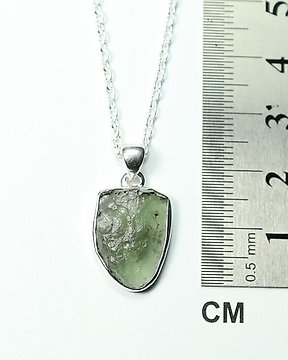
Moldavite Pendant / with silver chain/ new - 5.6 g - (1)
No. 83062791

No. 83062791

New pendant Libyan desert glass / Moldavite
925 sterling silver / leather strap
New and unworn
The origin of desert glass is uncertain. Meteoritic origins have long been considered possible, and recent research links the glass to impact features, such as zircon-breakdown, vaporized quartz and meteoritic metals, and to an impact crater.Some geologists associate the glass with radiative melting from meteoric large aerial bursts, making it analogous to trinitite created from sand exposed to the thermal radiation of a nuclear explosion. Libyan Desert glass has been dated as having formed about 26 million years ago. It was knapped[citation needed] and used to make tools during the Pleistocene.
Moldavite (Czech: Vltavín) is an olive-green or dull greenish vitreous substance possibly formed by a meteorite impact in southern Germany (Nördlinger Ries), which would make it one kind of tektite. They were introduced to the scientific public for the first time in 1786 as “chrysolites” from Týn nad Vltavou in a lecture by professor Josef Mayer of Prague University, read at a meeting of the Bohemian Scientific Society (Mayer 1788). Zippe (1836) first used the term “moldavite” derived from the town of Moldauthein (Czech: Týn nad Vltavou) - now in Bohemia (the Czech Republic), from where the first described pieces came.
Dimensions: 30,8 x 14,7 x 6,6 mm
Totalweight: 3,56 g (without leather strap)
Authenticity guaranteed by IMCA member #0099.
registered priority airmail
How to buy on Catawiki
1. Discover something special
2. Place the top bid
3. Make a secure payment